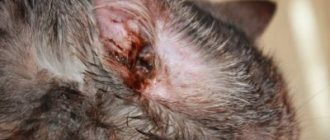Head shaking in cats can occur for a variety of reasons, both simple and more serious. In many cases, your cat's head bobbing may simply be a symptom of a benign temporary abnormality, such as a stressful situation or overheating. However, it can also be a sign of a more serious condition that may require veterinary intervention.
Sudden head shaking in felines can cause stress, but there is usually no cause for concern. In this article, we will look at the common causes of this unusual behavior in cats and possible solutions. Let's start!
Possible reasons
When a cat begins to shake its head more than usual, the owner needs to keep in mind the following reasons:
Otitis;- Entry of a foreign body into the ear canal;
- Demodectic mange;
- Allergy;
- Injuries;
- Otodectosis;
- Neoplasms.
In rare cases, severe head injuries can cause constant head shaking, but such signs cannot be confused with anything else.
A common disease that never appears on its own. Otitis is always provoked by something. Most often this is a bacterial infection, an allergic reaction or otodectosis. It can be acute or chronic. The following symptoms are characteristic of otitis media:
discharge from the ears;- unpleasant odor;
- itching;
- redness;
- peeling.
At the same time, the cat shakes its head and tears its ears until they bleed. Cleaning does not lead to anything, since the root cause must be eliminated. In decorative breeds, otitis media can be caused by food allergies, which are always aggressive in them. Only nutritional correction will help here. In common breeds, otitis may be triggered by an allergy to flea bites or saliva. Things are more complicated with otitis caused by formations in the ear canal. Due to constant contamination, it is impossible to inspect the ear canal. Otoscopy is also indicated. I would also like to draw attention to the fact that in the same cat, otitis media in one ear can be caused by a bacterial infection, and in the other by a fungal infection. That is why it is recommended to conduct a cytological examination from both ears.
Main symptoms
To an attentive owner, the nature of ear discharge can tell a lot. And the cause for concern is the accumulation of a substance inside the ear with an unpleasant and pungent odor. Impurities of pus or blood indicate that the disease has progressed to a severe form.
In this case, the cat must be urgently shown to a specialist who will diagnose and prescribe appropriate treatment. Otherwise, more serious problems may arise - disruption of the integrity of the eardrum with subsequent deafness.
Foreign body
A foreign body entering the ear canal causes the cat to shake its head and behave restlessly. If the splinter is not removed in time, the development of purulent otitis media is inevitable. The foreign body can be thorns from a cactus, plants, or the remains of claws after a fight with relatives. When removing the splinter yourself, it is recommended to thoroughly disinfect the wound and the tools that will be used to remove the splinter. If after extraction no purulent discharge or unpleasant odor appears within 3-5 days, then we can assume that everything went well. Otherwise, it is better to immediately take your pet to the veterinarian.
Video “Drooling with pleasure”
Cats, relaxed with pleasure, can also drool. In this case, the animal’s jaw muscles simply relax, as, for example, in our video.
This article provides basic general information on this issue, as well as answers to questions that veterinarians in various veterinary clinics constantly face in their practice.
Drooling in cats during sleep: causes and treatment
Excessive drooling even during sleep can be a sign of illness in the animal. Before going to the vet, keep an eye on your pet for a day. If drooling also flows profusely during the daytime, then immediately contact a doctor and explain to him in what situation the cat was drooling, so that the veterinarian can quickly make a diagnosis.
Drooling in a cat in the heat and sudden what is it and how to help
During the heat, cats' bodies overheat and the pet's first defense mechanism is drooling. In this way, their body cools itself, so there is no need to help the cat, at this moment it helps itself.
Drooling in cats from stress, dry food, kidney failure, after anesthesia and surgery, rabies or taking medications
Regarding the animal's mental health, cats salivate profusely during times of stress. Also, during times of nervous tension, they may wash their faces frequently, which also refers to frequent drooling.
During kidney failure in cats, saliva is released suddenly and continues for an hour and a half, which is a sure sign to take your pet to the vet.
Dry food, especially new food, can also cause excessive drooling. Firstly, this is due to the expectation of something tasty. Secondly, dry food is dry because it needs to be thoroughly moistened, which is why more saliva is produced than usual.
If a cat has become infected with rabies, then drool is an eternal companion of this disease. The pet changes in behavior and in some cases the saliva may contain blood. Such an animal is quickly placed in quarantine, as it becomes dangerous to others.
Surgery, injections, medications are always stressful for the animal, so drooling after such manipulations is normal. Your pet is simply experiencing nervous tension, which is why saliva is released.
The kitten has profuse and increased salivation, what should I do?
First of all, you need to figure out why the kitten has increased drooling. This can be either contact with a plant or a foreign object in the oral cavity. If saliva does not stop flowing after an hour and a half, then it is better to consult a doctor, since prolonged drooling is a sign of many diseases, in some cases even fatal.
Why does a cat drool with blood from its mouth, what is wrong with it and how to treat it
There can be a lot of reasons for such a tragedy - from a foreign object getting into the throat to poisoning and viral diseases such as rabies. They are treated only according to a doctor’s indications, since blood from the mouth is a sure sign of a serious illness, unless the cat has damaged its tongue or gums.
Why does a cat drool from his mouth when you pet him or when he purrs?
Healthy animals do not have the habit of drooling, but many drool when petted. It is possible that in this way they show their happiness from such a process.
The cat is drooling and sticking out its tongue, what could it be?
Typically, cats stick out their tongues and drool to cool their bodies. In this case, the only thing to worry about is that the cat could get sunstroke. A cold compress will help your pet feel better.
A cat is drooling after a suprastin injection, how to help
For a cat, an injection means stress, which he experiences by producing copious amounts of saliva.
The cat is drooling while driving in the car, what to do?
Cats not used to riding in a car. They, like many people, get motion sickness, which is the reason for drooling while driving.
In this matter, many people have ambiguities, which can be sorted out in the material of this article, written in the format of questions and answers. If os...
Cat owners may experience a variety of illnesses in their pets. Symptoms include bad breath and excessive drooling.
When a cat has bad breath (ammonia, putrefactive or acetone), this indicates an imbalance in his body. This problem is medically called halitosis (halitosis).
Allergy
It can often manifest itself as dirty ears, itching, redness and baldness in specific areas of the body. In severe forms, the cat shakes its head and scratches its ears. You can see black discharge inside the ear canal. If there is a strong odor, then there is a possibility of a fungal or bacterial infection. This reaction is almost always provoked by incorrectly selected food and feeding the pet from the table. You also need to rule out flea dermatitis and allergies to parasites. Decorative breed cats (British, Scottish, bobtails, sphinxes, etc.) are prone to allergies. You need to understand that it will not be possible to get rid of dermatitis once and for all, so the animal will need special care throughout its life (hypoallergenic food, timely worming and flea treatment).
Signs
The most common signs of vestibular system disease are:
- ataxia (lack of coordination and balance);
- head tilt;
- movement in a circle;
- falling to one side of the body;
- nausea (motion sickness);
- strabismus (deviation of the eyeballs) and nystagmus (anterior and posterior, superior and inferior, or rotational movement of the eyes).
The cat will fall, spin, or tilt its head towards the side of the body where the main disturbance is located.
Diseases of the vestibular apparatus are divided into peripheral (if the disease lies in the inner ear) and central (if the brain stem is affected). In addition, signs of the disease can be unilateral or bilateral. Cats with bilateral peripheral problems exhibit weakness due to a feeling of disorientation; but the muscles of their limbs function normally.
Deficits in postural responses such as placement and proprioception of the limbs may be present, along with mental decline (depression or decreased consciousness). Rarely, a form of central vestibular disease affects the side of the body opposite the affected side. The development of neurological deficits in a cat's head may involve loss of sensation or movement of the face.
Injuries
Domestic cats experience fewer injuries, since there are many risks on the street in the form of fights with relatives or other animals. If the injury is severe (for example, after a fall from a height), the pet may shake its head for a while and lean to one side. If this condition does not go away within 24 hours, it is recommended to immediately take him to the nearest veterinary clinic. To make a diagnosis, it will be necessary to exclude injuries to the skull, cervical spine, and concussion. Injuries can also include insect bites, after which the cat not only shakes its head, but also rushes around the house. We are talking about wasp and bee stings in the area of the nose, lips, ears and eyes. The bite site always swells and turns red. It is recommended to immediately give your pet an antihistamine (Fenistil, Cetirizine).
The cat's drool flows like clear water, in drops
With increased salivation, the cat has a wet chin, throat, and fur. The cat often swallows saliva, rubs its face on furniture, and washes itself excessively. Long hair gets matted into icicles. The litter becomes covered with wet spots. This may indicate other problems. Manifestations of excessive salivation are a manifestation of an illness that needs to be identified as early as possible. Among cat diseases, clear drooling corresponds to most diseases
except for rabies.
With rabies, salivation will flow foamy, but this can also happen after taking a bitter medicine. When a cat has rabies, he drinks little, goes to dark places, avoiding bright light, as it contributes to eye pain. During this period, the cat falls into an aggressive or apathetic state. This is lethal for a cat, but the animal can also infect a person through a bite, and this can have a bad effect on human health. Therefore, if saliva comes out in the form of foam, you should find out about the nature of the disease from a veterinarian.
Neoplasms
Often found in individuals after 5 years of age. They have benign (polyps, papillomas) and malignant
nature (sarcoma, lymphoma, carcinoma, melanoma). Almost always, all neoplasms provoke the development of otitis media and discharge from one (affected) ear. In advanced cases, the cat shakes its head and leans to the side. For single polyps of small size, you can limit yourself to observation and in the absence of growth and inflammation, you can leave it alone. If the polyp increases in size or provokes otitis media, then its removal is necessary. The prognosis is favorable in most cases. Everything is more complicated with malignant tumors, due to which blood and pus can be released from the ears. There is a foul odor. To confirm the diagnosis and determine the stage of the tumor, otoscopy, MRI of the head and radiography are performed. In the absence of metastases, surgical excision of the formation is performed, including healthy tissue (in 70% of cases, the entire ear canal is removed). And even if the operation is successful, the prognosis is cautious, since malignant tumors in the ears are prone to recurrence.
Ear infection in a cat
A cat's ear can become inflamed at all levels. This applies to the external auditory canal, structures of the middle, and also the inner ear. Such pathological changes in a cat’s ears occur as a result of infection, after suffering or poorly treated scabies, due to violation of the rules of care or cleaning of the ear canals, and even allergic reactions to household chemicals and food. Depending on the nature of the inflammatory process and its scale, a typical clinical picture for each type of inflammation will develop.
When the cat is inflamed, it constantly scratches its ear and shakes its head, its overall body temperature rises, coordination of movements is impaired and interest in food, games, and the outside world disappears. Such an animal most often tilts its head to the painful side, begins to hear poorly, does not respond to its name, and becomes clearly irritable. Inflammation in a cat's ears is a very serious disease. If left untreated, the animal risks remaining deaf or the pathological process can spread to the brain structures, which is often fatal.
Why does a cat shake its head?
While observing his pet, the owner may notice some oddities in his behavior. For example, he notices that the cat is shaking its head and at the same time scratching its ears with its paws. A suspicious person may suspect something wrong in any trifle, however, some vigilance never hurts, especially when it comes to cat ears. A cat has naturally very acute hearing, so its ears are very important to it. Problems with the hearing organs can bring her a lot of trouble.
If a cat shakes its head and scratches its ears, could this be an alarming symptom, or should it not be paid any attention to?
Pathological signs
Minor rare scratching (2-3 times a day) and head shaking cannot be called odd: all living organisms scratch and shake their heads, cats are no exception. But if the cat begins to itch constantly and at the same time tears his ears with his paws with all his might, you should pay special attention to this. These symptoms are often accompanied by other alarming signs that should alert the pet owner. These are the signs:
- The animal behaves restlessly, gets irritated and nervous for no reason.
- The cat actively shakes its head, tilts it down or to the side.
- When scratching its ears, the pet emits a hiss or an angry purr, and meows pitifully and loudly.
- Scratching left bloody marks inside and around the ears.
- The cat is trying to rub its muzzle and ears on everything around it.
- It is possible that the cat's body temperature may increase.
- The animal does not allow its ears and head to be touched, reacting painfully to any touch.
- The inner surface of the ear becomes red or swollen.
- Various discharges flow from the ear.
- Brown crusts and ulcers appeared in the ear.
Have you noticed this behavior in your cat? So it's time to see the vet.
What to do, how to help a cat depending on the problem at home
If you discover that your cat has ear problems, you can provide first aid to her at home. When otodectosis or sulfur plug occurs, it is possible to carry out all the treatment on your own.
In the first case, it is enough to buy drops at a pet store and carry out the course according to the instructions of the drug, and in the second, instill saline solution into the ear canal blocked by a plug several times a day for a week.
When treating a hematoma in an animal, the auricle is lubricated with absorbable ointments, such as Troxevasin and Troxerutin. It is unacceptable to try to open a hemorrhage yourself.
With otitis media, treatment on your own is impossible. As a last resort, it is permissible to clean the ear with a cotton swab moistened with hydrogen peroxide, followed by placing Levomekol ointment in the ear. Antibiotic injections are prescribed only by a veterinarian.
Reasons for strange behavior
If a cat's ears itch and it shakes its head, then the reason may be hidden in the most ordinary phenomena. This, for example, could be earwax that has accumulated in large quantities or water that has penetrated into the auricle during water hygiene procedures. Or perhaps a foreign object has gotten into your pet’s ear, or there are fleas.
There are other factors that may explain why a cat shakes its head. These symptoms are caused by specific cat diseases, as well as pathologies common to both humans and cats. Here are the main ones of these ailments:
- inflammation of the ear canal (otitis media);
- presence of tumors;
- hematoma or other head injury;
- fungal infection of the skin of the ears;
- dermatitis;
- allergic reaction;
- ear mites or other parasites that cause scabies.
All these conditions require specialist consultation and immediate treatment.
First, it’s worth taking a closer look at some of the most common diseases of furry pets.
Reaction to medications
A bad reaction to medications can cause cats to shake their head and, in severe cases, even cause seizures. Your cat may have a bad reaction to certain medications, which is quite common even with medications approved for cats. Never give your cat medications that are not prescribed or at least approved by your veterinarian, as this can cause serious side effects. Reactions to medications are often accompanied by other symptoms, such as nausea or diarrhea.
If your cat is taking medication and you suspect that this may be the cause of his head shaking, ask your veterinarian if another medication is available.
Ear mites
This mite is not dangerous to humans; it lives and reproduces only in animals, causing ear scabies or otodecosis in them. Adult dogs and cats rarely suffer from scabies, but ear mites are found much more often in puppies and kittens.
The parasite is localized in the ear area or around it. In the animal's ears, you can notice a sticky brown liquid that dries and crusts over the skin of the ear. To diagnose the disease, a scraping is made from the skin in the ear area. The owner himself can notice the tick using a magnifying glass.
Sarcopid mites
If your cat's ears are shaking, this could be a sign that she has another type of mite. Such mites can spread not only in the ear area, but also in other parts of the cat’s body. They cause another feline disease, notoedrosis.
The head is affected first, then the entire body. The skin at the site of infection becomes dry and dense, covered with a crust, and the crust subsequently cracks.
To make an accurate diagnosis, you need to show the cat to a specialist. He will take a sample from the surface of the skin for analysis. Only the outermost layer from the inflamed area is scraped off; ticks can be seen there.
Both types of ticks provoke severe itching in the animal, forcing them to scratch the skin until it bleeds. Scabies that affects the ears can lead a cat to deafness or meningitis; in especially severe cases, the death of the pet can occur.
Otitis and its varieties
Otitis is an inflammatory process affecting the external, middle or internal auditory canal. There may be several reasons for the development of such a pathology:
- excess wax in the ears;
- colds caused by prolonged exposure to the cold;
- foreign bodies entering the ear;
- infections;
- allergy;
- diseases of internal organs (liver, pancreas);
- fungus;
- complication of notoedorza or otodecosis.
To prescribe the correct treatment, it is necessary to diagnose the cause of the disease in a specialized laboratory. The veterinarian must take a swab from the cat's ear for analysis.
In addition to ordinary otitis, in cats there is otitis of a bacterial nature, when a secondary bacterial infection is added to the inflammation of the ear.
In this case, the so-called bacterial or secondary otitis develops. It can be recognized by the abundant discharge of pus.
Otitis of mixed etiology also occurs in animals. This happens when the ear is affected by several types of otitis media at once. In this case, the disease occurs in a particularly severe form and causes serious complications.
How to help your pet
Options for providing assistance to the injured animal are selected after establishing the exact cause of the pathological condition.
Removing wax plugs at home
The cat begins to shake its head if it is bothered by wax plugs. You can clean your pet's ears yourself. Saline solution or hydrogen peroxide will help in this situation. The selected product is instilled into the ear canal, 2-3 drops three times a day. The treatment course lasts 7 days . Subsequently, the animal usually successfully copes with this problem on its own.
If the cat is unable to remove the plug, the owner himself can remove it using a cotton-tipped swab or a piece of gauze. As a last resort, it is recommended to contact a veterinary clinic.
Surgical intervention
Surgery may also be recommended in cases of chronic otitis media, which results in narrowing of the ear canal.
How to treat
To treat a disease, you first need to identify it. And the therapy itself will depend on why the disease occurred and how advanced it is. The doctor will also take into account the characteristics of the cat’s body.
Is it due to infection? The animal is prescribed special drops with a wide spectrum of action. Were parasites found? Special antiparasitic drugs are used. To treat allergies, systemic medications are used and complete abstinence from the product (or food) that caused the allergy is practiced.
At an early stage of the disease, therapeutic treatment is sufficient. Surgical interventions are required only if the ear canal has become too narrow or it is necessary to excise the affected tissue as a result of the development of necrosis.
Preventive measures
To prevent ear problems in cats, consider the following tips:
- Inspect your animal's ears regularly, especially after walking outside.
- Do not allow the cat to come into contact with homeless relatives.
- Monitor the hygiene of your cat's ears, clean them of wax, dust, dirt, and foreign objects. This must be done carefully so as not to damage the ear canal.
- Periodically it is necessary to treat the cat against parasites with special means.
- When carrying out water procedures, avoid getting water into your pet’s ears.
- Help strengthen the immune system by providing nutritious nutrition enriched with vitamins and minerals.
Animals get sick just like people, and they suffer no less from it. Often neither dogs nor cats are able to help themselves, so the health of a pet is entirely in the hands of its owner. Of course, sometimes treating toothy and clawed pets is very difficult, but attentive attention and care will pay off in full.
Treatment of food poisoning
First of all, to restore the body, you need dietary nutrition, which will help restore normal functioning of the gastrointestinal tract (GIT).
When resuming nutrition after poisoning, general recommendations must be followed3:
- You need to eat often and in small portions.
- Fried, stewed, spicy, salty and fatty foods are strictly prohibited.
- Alcohol and carbonated sweet drinks should be forgotten during treatment and further recovery.
- It is important to maintain the serving temperature of the food - it should remain neutral - neither cold nor hot.
- The predominant cooking method is boiling and steaming.
- Dishes should be light, mostly lean and familiar to the body.
A home or traveler's first aid kit should always include anti-poisoning medications.
The most popular products3,4:
- Adsorbent preparations or sorbents. No first aid kit should be without such a product. The task of the sorbent is to absorb the toxin and its further removal from the body.
- Drugs to improve digestion. They help the body fully absorb food and will be especially relevant after defeating poisoning.
- Antispasmodics or painkillers. Spasms and pain in the stomach or intestines can also be the body’s reaction to an external “attack”. The task of such medications is to relax the internal muscles and relieve spasms, as a result of which the pain goes away.
When faced with food poisoning, it is first of all important to cope with the acute period of the problem, but it is equally important to think about the period of rehabilitation of the digestive system, because the inflammatory process disrupts its normal functioning. One of the consequences of such a disorder may be a lack of digestive enzymes, which are responsible for the breakdown and absorption of food in the body. As a result, the body experiences a deficiency of nutrients, and a person, even after recovery, may still experience unpleasant symptoms for some time - discomfort in the abdomen, heaviness after eating, periodic bowel movements, etc.
Pancreatin enzyme preparations may be useful to maintain digestion after poisoning5. They are called enzymatic because they contain digestive enzymes identical to those produced by the body and are included in the standard treatment of foodborne infections6.
Digestive enzymes are a special type of compound designed to break down carbohydrates, proteins and fats for subsequent absorption in the body.
The cat scratches its ears and shakes its head: the reasons for this behavior
It happens that a cat scratches its ears several times throughout the day, and may shake its head. This behavior is quite logical, because, as you know, these four-legged friends are very clean. Ear scratching is part of their daily hygiene.
The cat shakes its head
Head tremors in cats are observed before jumping onto a high object. It is also common for them to shake from the tip of their tail to their ears during a hormonal surge. During this period, males and females begin to behave in an unusual manner: they rush around and scream heart-rendingly. It is not surprising at this moment to notice how not only the whole body, but also the head begins to tremble.
Note! You need to watch your pet for some time to understand the reasons why the cat shakes its head.
Tremors can have several causes, and many of them are harmless. But if the frequency of scratching and twitching of the head is frequent, then it is worth giving importance to this. If a cat shakes its ears quite often, tilts its head to one side, scratches them, tearing the skin, this is already a signal to the owner about the possible presence of a disease. And what kind of disease we are talking about will be determined by the veterinarian.
Diseases of the deep parts of the ear
When the cat’s head shakes for the first time, you first need to inspect the ear canal. With diseases of the deep parts of the ear, it is difficult to recognize them externally, because there will be no discharge. But such a disease can be assumed by deterioration in coordination of movements.
Foreign body entering the ear canal
If a cat lives outside, pebbles, foreign objects, plant seeds, insects, and dirt often get into the ear. And pets are no exception. Head tremors occur when trying to shake out something unnecessary from the auricle. But it happens that the object itself later becomes the cause of inflammation.
Ear mite
A mite may appear in the ear and begin to multiply, which is why the cat constantly shakes its head. Parasites that have settled in the ear canal cause severe itching and irritation. This disease is called notoedrosis, it is caused by sarcoptoid mites. They appear on the body, and in the absence of necessary and timely treatment, they penetrate into the ears. They can be detected by the presence of the affected area with crusts and wounds with bruising. The addition of a secondary infection worsens the cat's health.
Ear diseases in pets.
So, if you notice a change in your pet’s behavior, you understand that the dog is constantly scratching its ear , and the cat is shaking its ears and scratching them, then it’s time for you to learn about ear diseases in pets and visit a veterinary clinic.
Major ear diseases that can cause itching.
- Otitis is inflammation of the ear. When microorganisms enter the ear, affecting the skin of the external auditory canal, causing swelling and secretion of mucus or even pus, otitis media begins to develop. It can be of three types - outer, middle and inner ear. If you suffered from otitis media as a child, you probably remember that this disease is quite painful and requires mandatory treatment. Otitis media is accompanied by general weakness of the animal, elevated body temperature and loss of appetite. The pet tilts its head to one side every now and then, the cat scratches its ears and shakes its head , and begins to hear poorly. Otitis media is a very serious disease that can lead to complete hearing loss – deafness. A complication of otitis is perforation of the eardrum and inflammation of the membranes of the brain. This disease must be treated under the constant supervision of a doctor. During treatment, antibacterial drugs are necessarily prescribed - drops, ointments, suspensions; in severe cases, antibiotic injections are included.
- Sulfur plug. In the ears of animals, as well as in the ears of people, there is sulfur - a lubricant for the ear canals. And quite often, pathogenic bacteria can develop in it. If you don't clean your pet's ears, so much wax can accumulate in the ear that it leads to the formation of a wax plug. A fold-eared cat scratches its ears very often for this very reason. You can remove the wax plug from your animal yourself using special hygiene lotions for the ears. Place lotion in the ear, wait a couple of minutes, massaging the base of the ear, and then remove the wax with a napkin. If you see that after the procedure the amount of wax in the ears has not changed and this still bothers your pet, the cat scratches its ear and meows - you need to contact a veterinary clinic.
- Hematoma of the auricle. A hematoma is an accumulation of blood under the skin of the auricle. The causes of hematomas are very commonplace - trauma, bruise, bite, scratch. As a result, the animal's ear may become swollen, pain may appear, and this, naturally, will begin to bother the animal. Even without initially seeing the hematoma itself, you will notice that the dog is shaking its head and scratching its ear. If the hematoma is small, it will resolve on its own. However, if the hematoma is large, then surgical intervention will be necessary - the doctor will make a puncture or incision to empty the hematoma.
- Tumor in the ear. Let us reassure you right away - a tumor in the ear in animals is extremely rare. It causes pain, bothers and disturbs the pet. Symptoms will be a change in behavior, refusal to eat, general fatigue and apathy, weight loss, the dog shakes its ears and scratches them, a cough and fever are possible. Only a doctor can make this diagnosis for the animal and prescribe further treatment. In 90% of cases, the tumor will be removed surgically.
- Ear scabies - otodectosis. But this disease, unfortunately, is very common in dogs and cats. It is caused by otodectos cynotis mites - these are microscopic parasitic mites that live in the ear of an animal. And these mites are widespread everywhere. Otodectosis in cats and dogs can appear, for example, after contact with another sick animal or with care items. Ear mites are the reason why a cat shakes its head and scratches its ears constantly, sometimes even until it bleeds. If your cat or dog never goes outside and has no contact with other animals, infection is extremely unlikely. There is no age or gender predisposition to otodectosis. Immunity to the disease is also not developed. Otodectosis is not contagious for humans! However, this disease is still not pleasant for humans. In rare cases, in humans, a tick can cause so-called pseudoscabies - the appearance of an itchy papular rash on the skin that occurs in response to tick bites. No treatment is required. When the parasite is eliminated from the animal, all signs of an allergic reaction in humans go away on their own. In animals, this disease is almost never asymptomatic. The most obvious sign is copious dry discharge of a dark brown color from the external auditory canals (in most cases symmetrical), in the form of ground coffee, sometimes the discharge looks like whitish scales and crusts; intense itching in the head area, behind the ears, and, as a consequence, the consequences of self-injury. In chronic cases, secondary fungal or bacterial inflammation may develop in the external auditory canals. In some cases, the mite causes damage not only to the ears, but also to the skin. The degree of itching varies between animals - in some, even a large number of mites causes mild itching, in others, a small number of mites provokes the development of severe itching, scratching and discomfort. As a rule, in such animals this is associated with a hypersensitivity reaction (increased susceptibility) to tick waste products. However, sometimes the disease is chronic in nature, since it can occur for a long time without obvious clinical signs. Is treatment necessary in this case? The unequivocal answer is yes. If left untreated, permanent damage to the ear can occur, including a ruptured eardrum or even hearing loss. Severe and constant itching will cause the dog to scratch its ears and desperately shake its head, forming ear bruises. It is necessary to treat ear mites only under the supervision of a veterinarian and only after an accurate diagnosis has been made. Your veterinarian will examine the ear using an otoscope. If an infection is found, he will take a sample using a swab. In most cases, the mite is easily detected when examining smears under a microscope. This is an important procedure for understanding which organisms are present in the ear canal and in what quantities in order to choose the appropriate treatment. With the right approach, otodectosis is highly treatable and just a few weeks are enough for the disease to disappear without a trace. The problem is that very often pet owners independently diagnose their pet with “otodectosis” and then unsuccessfully try to cure it for several years. Remember that some drugs may not only be ineffective, but also contraindicated for your animal. When treated in a veterinary clinic, the doctor, based on the test results, will prescribe local and systemic antiparasitic drugs. If secondary inflammation is detected, the doctor will additionally prescribe the ear drops your animal needs, based on the results of a cytological examination of smears from the external auditory canals. To prevent infection, your pet needs regular antiparasitic treatments.
Treatment of otodectosis in cats and dogs will be as follows. Initially, you will need to cleanse the ear of discharge and wax with hygienic lotion. Then the doctor will instill a medicine, for example Bars Forte ear drops or Aurizon ear drops , and massage the base of the ear for better distribution of the product. Even if a mite is found in only one ear, the medicine is instilled into both ears. You will need to do the same procedure at home 2-3 times a day, for several days. Then they conduct an examination again and take a scraping from the auricle.
The entire complex of treatment for otodectosis may include the following types of treatment:
- Ear drops,
- Ear flushing,
- Antibiotics and anti-inflammatory drugs,
- Changing your diet
- In very rare cases, surgery may be required
- To prevent scratching, it may be necessary to place a protective plastic collar around the animal's neck.
Diagnosis of ear diseases in cats
To understand what is hidden behind the cat’s behavior, it is necessary to conduct a thorough diagnosis.
The following studies will help determine the cause and make a diagnosis:
- examination of all parts of the body;
- general blood analysis;
- scraping from the affected area;
- histological examination of biopsy material;
- microscopic examination;
- bacteriological culture in case of detection of bacteria in a smear, also to determine antibiotic sensitivity.
Diagnostics of the auricle in the clinic
Based on the results of the examination, the veterinarian makes a diagnosis and prescribes appropriate treatment.
It is important to note that if you suspect the presence of ear scabies, it is mandatory to take the contents from the ear for analysis. But when complicated by bacterial otitis, detection of ticks is difficult, since they die in an acidic environment.
Ear cleaning
In order to prevent ear diseases and as a hygiene measure, it is necessary to clean cats' ears regularly. You can do this yourself at home, and those who are afraid or do not know how to carry out this procedure can seek help from a veterinary clinic.
The most important thing is to create a calm environment and not scare the cat. It is not necessary to hold it by force, tug and wrap it, it is enough to gently win the pet’s obedience.
Use a small piece of cotton wool to wipe the auricle from accumulated wax. Then you can drop a couple of drops of saline solution and massage your ear so that the liquid penetrates as deep as possible into the ear canal. Next, use a cotton swab to clean hard-to-reach places. Ear hygiene should be carried out at least once a month.
Information for cat owners.
The cause of severe itching and external otitis in cats in 50% of cases is otodectosis. To treat otodectosis in cats, you can use antiparasitic ear drops , drops on the withers, or injections of an antiparasitic drug.
Antiparasitic ear drops must be instilled at least 3 times with an interval of 5-7 days (this is due to the development cycle of the tick). For example, your veterinarian may prescribe Bars Forte ear drops for cats . This drug has the widest spectrum of action against pathogens; has a therapeutic effect for otitis caused by both microbes and fungi; has an anti-inflammatory effect. According to reviews from owners , Bars ear drops for cats are indeed very effective, affordable and easy to use. However, remember, if you drop drops into dirty ears, the drug will not be able to penetrate deep into the ear canal, and accordingly, the drops may not be able to start working. This is another reason why it is better to do this procedure at a veterinary clinic for the first time. Remember that only with the correct use of Bars ear drops for cats or any other ear drops, the treatment will be effective and will not cause discomfort in the animal.
Drops on the withers have an excellent therapeutic effect. This is especially useful for animals that react negatively to ear cleaning and drops. However, these drugs are expensive.
If the lesions are severe, injections of an antiparasitic drug (ivermectin) may be required. The drug is administered subcutaneously 3 times with an interval of 10 days. This is a 100% way to get rid of ear mites. The disadvantage of this method of treatment is pain when administering the drug, and the need to visit the clinic for injections.
Attention! Otodectosis is very contagious in cats , so it must be diagnosed and treated only by specialists at a veterinary clinic, and not from photos on the Internet. The sooner you start professional treatment, the faster your pet will recover!











